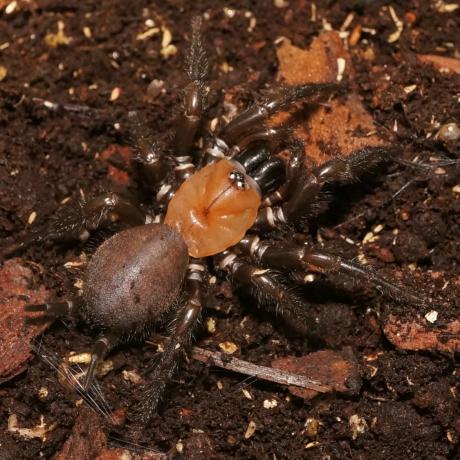

This spider was described by Peter Jackson as inspiration for the character Shelob in Lord of the Rings The Two Towers. They are heavy webbers and make interesting subjects to keep.
| Environment | Widespread |
|---|---|
| Lifestyle | Terrestrial |
| Adult Size | Up to 5cm |
| Growth Rate | Unknown |
| Temperament | Aggressive |
| Suitability | Experienced keeper |
A fairly large and bulky species with legspans reaching 5cm. Overall the spider has a black to dark brown appearance with a smooth orange carapace and dark setae hair over the abdomen and legs.
The chelicerae are large and bites are rumoured to be painful, cause localised swelling, itching, but are not dangerous to humans.
Not to be confused with a funnel-web spider. This species is found throughout New Zealand and the Chatham Islands in bush and gardens. They prefer living under stones and logs creating a silken tube with a wide entrance for prey detection.
House in a terrestrial style enclosure, singularly, and either in a plastic tank or a glass terrarium. Maintain temperatures between 18°C (64°F) and 22°C (72°F) using appropriate heating equipment (if necessary). Maintain a moderate humidity of 70% with occasional misting of the web and to provide a water source, use a hand or pump sprayer to do this.
Provide a moderate substrate layer of 5cm using a soil based substrate. Add small pieces of bark to the enclosure as a retreat and for something for the spider to silk up to and create the tunnel.
Feed on appropirately sized food such as crickets, locusts and waxworms.
Spiderlings should be kept in plastic vials or deli containers until big enough to house into larger enclosures without them escaping.